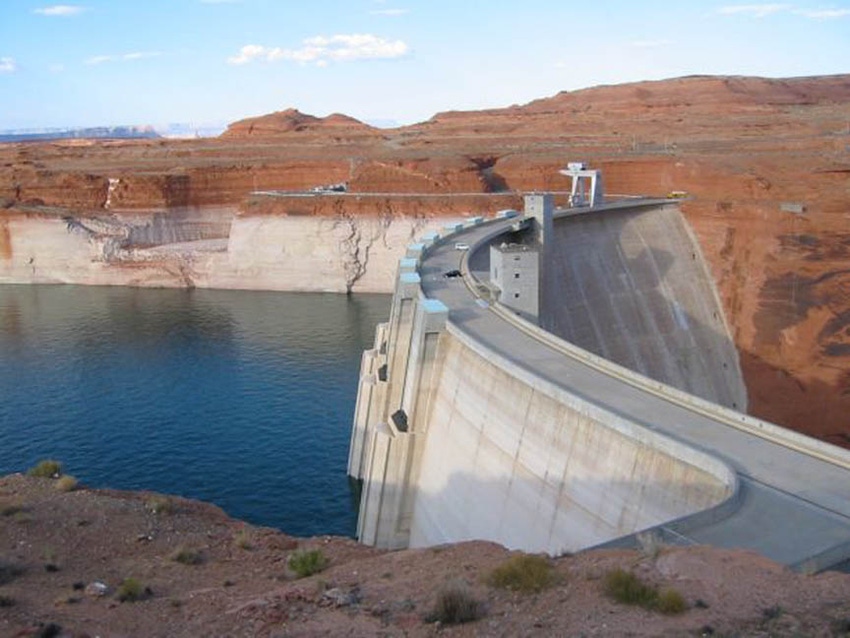June 26, 2013

Higher temperatures will be a key driver of future decreases in Colorado River flow, according to a new report from a team that includes University of Arizona scientists.
Previous scientific studies indicate by about 2050, the Colorado River will shrink because of climate change. However, their estimates of how much range from 6 percent less water to 45 percent less water.
To help water managers and policy makers understand why the wide range of estimates, a multidisciplinary team of scientists reviewed 16 scientific studies that project future Colorado River flows.
The team's paper, "Understanding Uncertainties in Future Colorado River Streamflow," was published online June 25 in the Bulletin of the American Meteorological Society.
"These previous studies all suggest less water in the future, and we confirm this," said co-author Jonathan T. Overpeck, co-director of the UA Institute of the Environment.
Lead author Julie Vano, who recently earned a University of Washington doctorate in civil and environmental engineering, said, "The different estimates have led to a lot of frustration. This paper puts all the studies in a single framework and identifies how they are connected."
Overpeck said, "The paper does the best job thus far in framing the challenge of maintaining water supply in the seven-state-plus-Mexico region served by the Colorado."
Knowing how much water will be in the river is crucial for water managers trying to plan for the coming decades: The Colorado River provides water for more than 30 million people, including those in the fast-growing cities of Las Vegas, Phoenix and Los Angeles.
The new paper establishes what is known about the river's future. Warmer temperatures will lead to more evaporation and thus less flow. Whether precipitation will change is less certain, but climate change is likely to decrease the amount of rain and snow in the Colorado basin.
"Even if the Colorado headwaters get no change in precipitation, the temperature increases – a sure bet – will drive lower flows in the river," said Overpeck, a UA professor of geosciences and of atmospheric sciences.
"It's surprising to me how much temperature increases alone will decrease flow in the Colorado," he said.
The team’s study does not provide new estimates of future annual flows of the Colorado River. Instead, it provides context for comparing the various scientific studies and explains why the different types of previous studies produced different predictions.
Ground zero
For example, the estimate of 6 percent reduction did not include some of the fourth-generation climate model runs that tend to predict a dryer West. The high-end estimate of 45 percent relied on an analysis that overestimated how much increased temperatures would cut flows from the Colorado’s high-elevation headwaters.
UW co-author Dennis Lettenmaier said, "The Colorado River is kind of ground zero for drying in the southwestern U.S."
In addition, the report calls on scientists to focus on what is known, rather than on uncertainties, when helping managers understand the implications of multiple studies.
"We hope this paper sheds some light on how to interpret results from the new generation of climate models, and why there's an expectation that there will be a range of values, even when analyzing output from the same models," said Lettenmaier, a UW professor of civil and environmental engineering.
The authors include leaders in Western water issues, including specialists in atmospheric sciences, hydrology and paleoclimate.
The other co-authors are Bradley Udall of the University of Colorado in Boulder; Daniel Cayan, Tapash Das and Hugo Hidalgo of Scripps Institution of Oceanography, UC San Diego; the UA’s Holly Hartmann and Kiyomi Morino; Levi Brekke of the Bureau of Reclamation; Gregory McCabe of the U.S. Geological Survey in Denver; Robert Webb and Martin Hoerling of the National Oceanographic and Atmospheric Administration in Boulder; and Kevin Werner of the National Weather Service in Salt Lake City.
The team identified four main reasons for the variation in flow estimates among the studies reviewed.
The most important source of difference was that different studies used different climate models and levels of future greenhouse gas emissions to predict future flows.
Next in importance was how well the models captured the effect of topography on the distribution of snow in the Colorado River's mountainous headwaters.
Third was which rainfall-runoff model was used to show how future changes in precipitation and temperature would affect the land's ability to absorb, evaporate or transport water.
The final source of differences in flow rates was which method was used to apply information from the large-scale global climate models to smaller-scale regional hydrology models.
The authors intend scientists, policymakers and stakeholders to use the new study to judge future estimates.
The research was funded by the National Oceanic and Atmospheric Administration through its Regional Integrated Sciences and Assessments Program and its National Integrated Drought Information System.
Overpeck said, "Temperature affects a bunch of things, but especially the snow in Colorado."
"Drought and climate warming are a one-two punch for our water supply,” he said. “We can lessen one of those two blows by reducing global warming by reducing our use of fossil fuels."
More from Western Farm Press
Oregon GMO mystery wheat is a whodunit
Meteorite find a golden harvest for farmer
What a grocery store without honey bees looks like
You May Also Like




